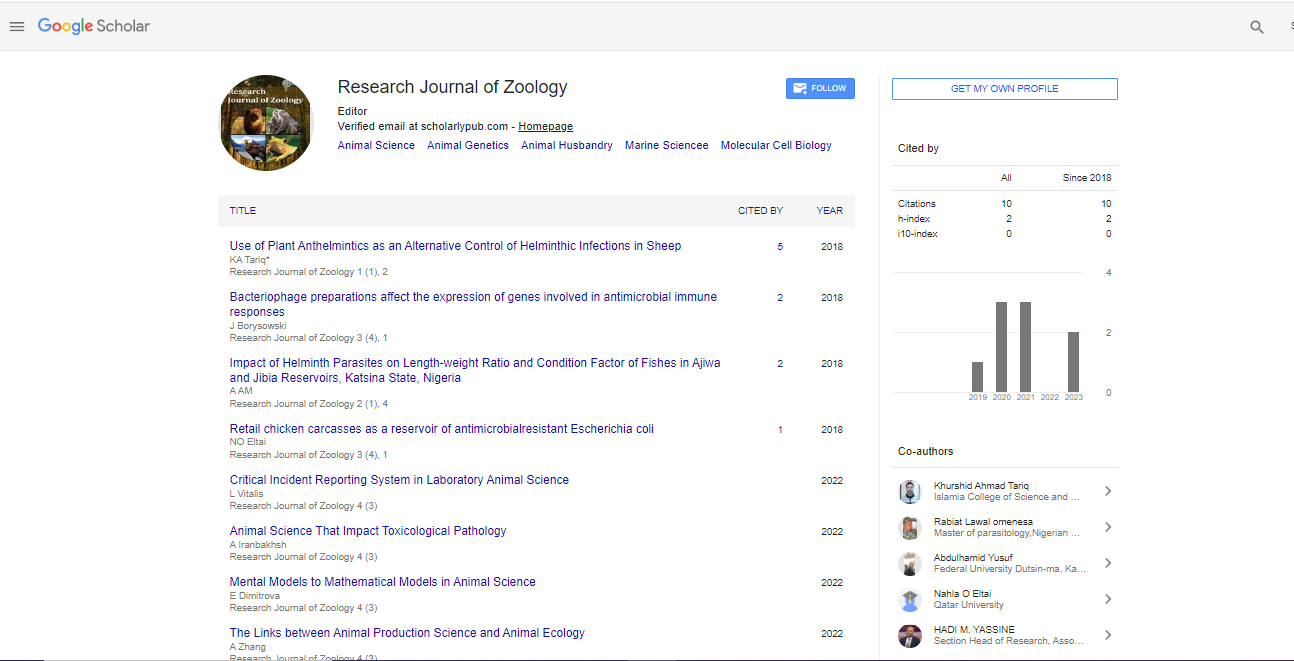Commentary, Res J Zool Vol: 5 Issue: 4
Symbiosis of Life: Exploring the Marvels of Animal Habitats
Hue Jingzhen*
1Department of Zoological Sciences, University of Duke, Durham, USA
*Corresponding Author: Hue Jingzhen,
Department of Zoological Sciences,
University of Duke, Durham, USA
E-mail: jing.huez@gmail.com
Received date: 21 November, 2023, Manuscript No. RJZ-24-128396;
Editor assigned date: 23 November, 2023, PreQC No. RJZ-24-128396 (PQ);
Reviewed date: 07 December, 2023, QC No. RJZ-24-128396;
Revised date: 15 December, 2023, Manuscript No. RJZ-24-128396 (R);
Published date: 22 December, 2023, DOI: 10.4172/RJZ.1000097.
Citation: Jingzhen H (2023) Symbiosis of Life: Exploring the Marvels of Animal Habitats. Res J Zool 5:4.
Description
In the extensive material of the natural world, animal habitats develop as performances where life exhibits in multiple manifestations. From the enormous expanses of oceans to the dense covering of tropical forests, animal habitats encapsulate the diverse environments that shape the survival, behavior, and evolution of countless organisms.
Animal habitats encompass a phenomenal array of ecosystems, each characterized by distinct environmental conditions, resources, and ecological dynamics. Generally categorized, these habitats include terrestrial ecosystems such as forests, deserts, grasslands, and tundras, as well as aquatic ecosystems such as oceans, rivers, lakes, and wetlands.
The complexities of animal habitats are exemplified by the coral reefs, vibrant ecosystems that filled with life under the sea's surface. Here, an expand symphony occurs because corals provide protection for a wide range of fish, in addition the fish, contribute to the coral's health through symbiotic connections. Such delicate balances are not unique to coral reefs but are echoed throughout the animal kingdom in different forms and adaptations.
Interconnectedness of habitats
While individual habitats may develop distinct, they are complexly interconnected, forming a dynamic and interdependent web of life. Migration is a prime example of this interconnectedness, as many organisms traverse multiple habitats during their annual study. For instance, the arctic Bird travels from its breeding grounds in the Arctic to the Antarctic and back, covering astonishing distances and depend on diverse habitats for various aspects of its life cycle.
Wetlands serve as essential connectors between terrestrial and aquatic ecosystems, providing breeding grounds for numerous organisms, while also filtering and purifying water. Mangrove ecosystems, with their distinct combination of terrestrial and marine features, demonstrate the interconnectedness of habitats, serving as nurseries for fish and providing coastal protection.
Human impact on habitats
As custodians of the planet, human activities produce significantly effects on animal habitats. Habitat destruction, pollution, climate change, and urbanization pose significant threats to ecosystems worldwide, leading to habitat fragmentation and loss. Deforestation, driven by agriculture and logging, disrupts the intricate balance of rainforest ecosystems, jeopardizing the survival of countless organisms.
Climate change alters temperature and precipitation patterns, impacting habitats from polar ice caps to tropical coral reefs. The melting of Arctic ice threatens the habitats of polar bears and seals, while rising sea temperatures contribute to coral bleaching, imperiling the delicate balance of marine ecosystems.
Conservation efforts desire to reduce the impacts of human activities on habitats, emphasizing the importance of preserving biodiversity, restoring degraded ecosystems, and promoting sustainable practices. Protected areas, such as national parks and reserves, play an important role in safeguarding habitats and the organisms that inhabit them, providing havens for animals to grow.
Educating and raising awareness
Understanding the importance of animal habitats is essential in fostering a sense of responsibility toward the conservation of biodiversity. Education and awareness initiatives play a significant role in highlighting the significance of preserving habitats and the delicate balance that sustains ecosystems. Zoos, aquariums, and nature reserves serves as an educational hub, providing opportunities for people to connect with the wonders of the natural world and gain insights into the challenges faced by different organisms in their native habitats. Conservation organizations utilize these platforms to raise awareness about the importance of sustainable practices, habitat preservation, and the interconnectedness of all life on Earth.
 Spanish
Spanish  Chinese
Chinese  Russian
Russian  German
German  French
French  Japanese
Japanese  Portuguese
Portuguese  Hindi
Hindi 
